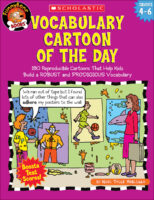Explore Vocabulary as a Class Through This Illustration Activity
Here’s how one fifth grade teacher revitalized her word wall and used illustrations to make vocabulary “stick.”
What does a conjunction look like? What about a verb or a preposition? Can you draw a picture of a delta or an inundation?
When she started teaching fifth grade, experienced primary educator Julie Ballew realized that she needed to rethink her word wall to best meet the needs of her older students. Word walls can be a powerful tool for reading, writing, and spelling, but in the fifth grade, sight words are less useful for students who read widely and successfully.
As she tried to maximize the usefulness of her word wall, Ballew was also working hard to improve her vocabulary instruction. She tried various methods to help her students with their most challenging words, including content-area word banks and color-coded word cards, but there was little stickiness.
It wasn’t until she combined her word wall and vocabulary instruction with visual aids that Ballew was able to successfully tackle both issues.
Using Word Walls for Curriculum Vocabulary
While knee-deep in an exploration of Ancient Egypt for their social studies curriculum, Ballew’s class generated a lengthy list of vocabulary words. Rather than posting the vocabulary words to a separate space for content area words, Ballew knew it was time to rethink her word wall.
Her students compared the social studies vocabulary words they collected in their notebooks and selected 20 words that everyone agreed must be understood to move forward in their study. To increase understanding and help students distinguish between challenging words like Kemet (fertile land near the Nile River) and deshret (dry desert land away from the river banks), Ballew decided that her students should illustrate the vocabulary words before adding them to the word wall.
Illustrations Help Make Vocabulary 'Stick'
Ballew realized that illustrations would help her students with all of their vocabulary words, not just the most confusing ones. Visual cues are important for memorization and learning, and having the students illustrate the words themselves was also a great way to assess their understanding so far.
Ballew wrote each vocabulary word on an index card and took suggestions for how her students might illustrate each one before distributing the cards. Many of the vocabulary words were concrete and fairly easy to illustrate, but the students were also able to depict more abstract words like plentiful and cultivate.
Illustrating Parts of Speech and Beyond
For their next challenge, Ballew’s students illustrated the parts of speech as part of their grammar review lesson. Many students were struggling with the distinction between pronoun and proper noun, as well as adverb versus adjective. But how would they illustrate a word like conjunction?
With fewer words to illustrate, the students worked in teams and once again rose to the challenge of turning abstract vocabulary into concrete illustrations. With these new visual aids, Ballew’s fifth graders were able to revitalize their classroom word wall and find a new way to meaningfully review vocabulary words while boosting comprehension and stickiness.
Challenge your students to illustrate their own curriculum vocabulary words, and see how it transforms your word wall and students’ vocabulary mastery. Scholastic’s Word Workshop is an easy online tool to help you generate word cards in various sizes and styles. Simply type, style, and print, and then hand off the cards to your students so they can work their illustrative magic.
Shop professional development books for teaching vocabulary below! You can find all books and activities at The Teacher Store.
What better way to make vocabulary words stick than through funny and engaging cartoons? Just one cartoon a day, complete with clear, simple definitions and sentences, will help build students' vocabulary and boost their reading, writing, and test-taking skills.
Build word power with 24 ready-to-reproduce, 3-page lessons! Each lesson teaches ten words, and includes research-based activities that tap students' prior knowledge for greater understanding and give them multiple encounters with new words so they really remember them.
Watch students’ vocabulary flourish as they read high-interest science text passages. Each weekly packet comes with three reproducible sheets that introduce four vocabulary words through a short, engaging article and reinforce students’ learning through a variety of activities.
This book details how best to use concept sorts and includes extension activities and reproducible word and picture cards for 15 key topics in science, social studies, and math.
Kids climb to new heights in reading and writing with these engaging, reproducible word building games!











